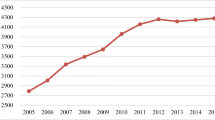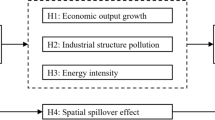Abstract
Urbanization is an important direction for China’s future social development and an important focus of its carbon emission reduction path. China’s current administrative management is a vertical nested structure, and the characteristics of high-scale regions have a non-negligible impact on low-scale areas. Taking the county scale of the basic unit of economic and social development as the research scale, according to the panel data of the Yangtze River Delta from 2008 to 2016, a two-level hierarchical linear model (HLM) for carbon emission intensity is constructed, especially considering the characteristics of high-scale regions (i.e., low-carbon pilot cities) at the second level, and is combined with the mediating effect test method to analyze the impact path of urban development on carbon emissions intensity. The results show that (1) there is a spatial nesting relationship between regions of different scales, and the city scale can explain 85.21% of the carbon emissions intensity, which is much higher than the county scale. (2) There is an N-shaped curve relationship between urban development and carbon emissions intensity. After considering the high-scale factor (low-carbon pilot cities) at the city scale (the second level of the HLM), if a high-scale city is a low-carbon pilot city, then improvement in the level of urbanization in the county can promote a reduction in carbon intensity. (3) The impact path of urban development ⇄ per capita gross domestic product (the proportion of secondary industry, patent application volume) → carbon emissions intensity and urban development → the proportion of tertiary industry → carbon emissions intensity is significant. However, the path of the proportion of tertiary industry → urban development → carbon emissions intensity is not significant.



Similar content being viewed by others
References
Abdallh AA, Abugamos H (2017) A semi-parametric panel data analysis on the urbanization carbon emissions nexus for the MENA countries. Renew Sust Energ Rev 78:1350–1356. https://doi.org/10.1016/j.rser.2015.04.046
Al-mulali U, Binti Che Sab CN, Fereidouni HG (2012) Exploring the bi-directional long run relationship between urbanization, energy consumption, and carbon dioxide emission. Energy 46(1):156–167. https://doi.org/10.1016/j.energy.2012.08.043
Ang BW, Su B (2016) Carbon emission intensity in electricity production: a global analysis. Energy Policy 94:56–63. https://doi.org/10.1016/j.enpol.2016.03.038
Aunan K, Wang S (2014) Internal migration and urbanization in China: impacts on population exposure to household air pollution (2000–2010). Sci Total Environ 481(1):186–195. https://doi.org/10.1016/j.scitotenv.2014.02.073
Cai BF (2013) Advance and review of city carbon dioxide emission inventory research. Chin Popul Resour Environ 23(10):72–80. https://doi.org/10.3969/j.issn.1002-2014.2013.10.011
Department of Climate Change, National Development and Reform Commission (2014) The People’s Republic of China national greenhouse gas inventory 2005. China Environmental Science Press, Beijing
Dietz T, Rosa EA (1997) Effects of population and affluence on CO2 emissions. Proc Natl Acad Sci 94(1):175–179. https://doi.org/10.1073/pnas.94.1.175
Ehrlich PR, Holdren JP (1971) Impact of population growth. Science 171(3977):1212–1217. https://doi.org/10.1126/science.171.3977.1212
Hang Y, Wang QW, Zhou DQ, Zhang L (2019) Factors influencing the progress in decoupling economic growth from carbon dioxide emissions in China’s manufacturing industry. Resour Conserv Recy 146:77–88. https://doi.org/10.1016/j.resconrec.2019.03.034
Huang F, Zhou DQ, Wang QW, Hang Y (2019) Decomposition and attribution analysis of the transport sector’s carbon dioxide intensity change in China. Transp Res A Policy Pract 119:343–358. https://doi.org/10.1016/j.tra.2018.12.001
Johnson HE, Sushinsky JR, Holland A, Bergman EJ, Balzer T, Garner J, Reed SE (2017) Increases in residential and energy development are associated with reductions in recruitment for a large ungulate. Glob Chang Biol 23(2):578–591. https://doi.org/10.1111/gcb.13385
Li K, Lin B (2015) Impacts of urbanization and industrialization on energy consumption/CO2 emissions: does the level of development matter? Renew Sust Energ Rev 52:1107–1122. https://doi.org/10.1016/j.rser.2015.07.185
Liu Y, Chen ZM, Xiao HW, Yang W, Liu DH, Chen B (2017) Driving factors of carbon dioxide emissions in China: an empirical study using 2006-2010 provincial data. Front Earth Sci 11(1):156–161. https://doi.org/10.1007/s11707-016-0557-4
Martínez-Zarzoso I, Maruotti A (2011) The impact of urbanization on CO2 emissions: evidence from developing countries. Ecol Econ 70(7):1344–1353. https://doi.org/10.1016/j.ecolecon.2011.02.009
Miao Z, Tomas B, Tian ZH, Shao S, Geng Y, Wu H (2019) Environmental performance and regulation effect of China’s atmospheric pollutant emissions: evidence from “three regions and ten urban agglomerations”. Environ Resour Econ 74:211–242. https://doi.org/10.1007/s10640-018-00315-6
Ouyang XL, Lin BQ (2017) Carbon dioxide (CO2) emissions during urbanization: a comparative study between China and Japan. J Clean Prod 143:356–368. https://doi.org/10.1016/j.jclepro.2016.12.102
Pablo-Romero MD, Pozo-Barajas R, Yniguez R (2017) Global changes in residential energy consumption. Energy Policy 101(1):342–352. https://doi.org/10.1016/j.enpol.2016.10.032
Pacheco-Torres R, Roldán J, Gago EJ, Ordóñez J (2017) Assessing the relationship between urban planning options and carbon emissions at the use stage of new urbanized areas: a case study in a warm climate location. Energ Buildings 136:73–85. https://doi.org/10.1016/j.enbuild.2016.11.055
Parikh J, Shukla V (1995) Urbanization, energy use and greenhouse effects in economic development: results from a cross national study of developing countries. Glob Environ Chang 5(2):87–103. https://doi.org/10.1016/0959-3780(95)00015-G
Rauf A, Zhang J, Li JK, Amin W (2018) Structural changes, energy consumption and carbon emissions in China: empirical evidence from ARDL bound testing model. Struct Chang Econ Dyn 47:194–206. https://doi.org/10.1016/j.strueco.2018.08.010
Rui H, Wang Z, Ding GQ, Gong YR, Liu CX (2016) Trend prediction and analysis of influencing factors of carbon emissions from energy consumption in Jiangsu province based on STIRPAT model. Geogr Res 35(4):781–798. https://doi.org/10.11821/dlyj201604015
Sadorsky P (2014) The effect of urbanization on CO2 emissions in emerging economics. Energy Econ 41:147–153. https://doi.org/10.1016/j.eneco.2013.11.007
Shahbaz M, Loganathan N, Muzaffar AT, Ahmed K, Ali Jabran M (2016) How urbanization affects CO2 emissions in Malaysia? The application of STIRPAT model. Renew Sust Energ Rev 57:83–93. https://doi.org/10.1016/j.rser.2015.12.096
Shao S, Guo LF, Yu ML, Yang LL, Guan DB (2019) Does the rebound effect matter in energy import-dependent mega-cities? Evidence from Shanghai (China). Appl Energy 241:212–228. https://doi.org/10.1016/j.apenergy.2019.03.007
Sharma SS (2011) Determinants of carbon dioxide emissions: empirical evidence from 69 countries. Appl Energy 88(1):376–382. https://doi.org/10.1016/j.apenergy.2010.07.022
Shi XC, Li XY (2018) Research on three-stage dynamic relationship between carbon emission and urbanization rate in different city groups. Ecol Indic 91:195–202. https://doi.org/10.1016/j.ecolind.2018.03.056
Smruti Ranjan B, Devi Prasad D (2017) The effect of urbanization, energy consumption, and foreign direct investment on the carbon dioxide emission in the SSEA (South and Southeast Asian) region. Renew Sust Energ Rev 70:96–106. https://doi.org/10.1016/j.rser.2016.11.201
Tian X, Chang M, Shi F, Tanikawa H (2014) How does industrial structure change impact carbon dioxide emissions? A comparative analysis focusing on nine provincial regions in China. Environ Sci Pol 37:243–254. https://doi.org/10.1016/j.envsci.2013.10.001
Wang Y, Zhang X, Kubota J, Zhu X, Lu G (2015) A semi-parametric panel data analysis on the urbanization-carbon emissions nexus for OECD countries. Renew Sust Energ Rev 48:704–709. https://doi.org/10.1016/j.rser.2015.04.046
Wang Y, Chen LL, Kubota J (2016a) The relationship between urbanization, energy use and carbon emissions: evidence from a panel of Association of Southeast Asian Nations (ASEAN) countries. J Clean Prod 112:1368–1374. https://doi.org/10.1016/j.jclepro.2015.06.041
Wang SJ, Fang CL, Wang Y (2016b) Spatiotemporal variations of energy-related CO2 emissions in China and its influencing factors: an empirical analysis based on provincial panel data. Renew Sust Energ Rev 55:505–515. https://doi.org/10.1016/j.rser.2015.10.140
Wang CJ, Wang F, Zhang XL, Zhang HG (2016c) Influencing mechanism of energy-related carbon emissions in Xinjiang based on the input-output and structural decomposition analysis. Acta Geograph Sin 71(7):1105–1118. https://doi.org/10.1007/s11442-017-1382-8
Wang Q, Wu SD, Zeng Y, Wu BW (2016d) Exploring the relationship between urbanization, energy consumption, and CO2 emissions in different provinces of China. Renew Sust Energ Rev 54:1563–1579. https://doi.org/10.1016/j.rser.2015.10.090
Wang QW, Hang Y, Su B, Zhou P (2018a) Contributions to sector-level carbon intensity change: an integrated decomposition analysis. Energy Econ 70:12–25. https://doi.org/10.1016/j.eneco.2017.12.014
Wang F, Lin XY, Liu J, Chen HT, Fan WN, Gao MN (2018b) Research progress on the impact of regional urbanization on carbon emissions. Ecol Envir Sci 27(8):1576–1584. https://doi.org/10.16258/j.cnki.1674-5906.2018.08.026
Wang Y, Yang G, Dong Y, Cheng Y, Shang PP (2018c) The scale structure and influencing factors of total carbon emissions from households in 30 provinces of China: based on the extended STIRPAT model. Energies 11(5):1–25. https://doi.org/10.3390/en11051125
Wang F, Fan WN, Chen C, Liu J, Chai W (2019a) The dynamic time-varying effects of financial development, urbanization on carbon emissions in the Yangtze River Delta, China. Environ Sci Pollut Res 26:14226–14237. https://doi.org/10.1007/s11356-019-04764-4
Wang F, Gao M, Liu J, Qin YH, Wang G, Fan WN, Ji LX (2019b) An empirical study on the impact path of urbanization to carbon emissions in the China Yangtze River Delta urban agglomeration. Appl Sci 9(6):1116. https://doi.org/10.3390/app9061116
World Bank (2014) World Development Indicators. http://data.Worldbank.org/data-catalog/world-development-indicators
Xu B, Lin BQ (2015) How industrialization and urbanization process impacts on CO2 emissions in China: evidence from nonparametric additive regression models. Energy Econ 48:188–202. https://doi.org/10.1016/j.eneco.2015.01.005
Yu SW, Zheng SH, Li X (2018) The achievement of the carbon emissions peak in China: the role of energy consumption structure optimization. Energy Econ 74:693–707. https://doi.org/10.1016/j.eneco.2018.07.017
Yuan Y, Xi QM, Sun TS, Li GP (2016) The impact of the industrial structure on regional carbon emission: empirical evidence across countries. Geogr Res 35(1):82–94. https://doi.org/10.11821/dlyj201601008
Zhang CG, Lin Y (2012) Panel estimation for urbanization, energy consumption and CO2 emissions: a regional analysis in China. Energy Policy 49:488–498. https://doi.org/10.1016/j.enpol.2012.06.048
Zhang L, Daniel T, Xie H, Chen WY, Wu YM, Jiang W (2005) CO2 emissions and their bearing on China economic development: the long view. J Geogr Sci 15(1):61–70. https://doi.org/10.1007/BF02873108
Zhang N, Yu K, Chen Z (2017) How does urbanization affect carbon dioxide emissions? A cross-country panel data analysis. Energy Policy 107:678–687. https://doi.org/10.1016/j.enpol.2017.03.072
Zhou B, Zhang C, Song HY, Wang QW (2019) How does emission trading reduce China’s carbon intensity? An exploration using a decomposition and difference-in-differences approach. Sci Total Environ 676:514–523. https://doi.org/10.1016/j.scitotenv.2019.04.303
Zhu BZ, Ye SX, Jiang MX, Wang P, Wu ZC, Xie R, Chevallier J, Wei YM (2019) Achieving the carbon intensity target of China: a least squares support vector ma-chine with mixture kernel function approach. Appl Energy 233-234:196–207. https://doi.org/10.1016/j.apenergy.2018.10.048
Funding
This work was supported by the National Natural Science Foundation of China, China (Grant No. 71673270); The Think Tank of Energy Mining Economy (2018 Project for Cultural Evolution and Creation of CUMT, China) (Grant No. 2018WHCC01); Fundamental Research Funds for the Central Universities, China (Grant No. 2242019K40171); and China Scholarship Council Project, China (Grant No .201806425016).
Author information
Authors and Affiliations
Corresponding author
Ethics declarations
Conflict of interest
The authors declare that they have no conflict of interest.
Additional information
Responsible editor: Eyup Dogan
Publisher’s note
Springer Nature remains neutral with regard to jurisdictional claims in published maps and institutional affiliations.
Rights and permissions
About this article
Cite this article
Wang, F., Wang, G., Liu, J. et al. How does urbanization affect carbon emission intensity under a hierarchical nesting structure? Empirical research on the China Yangtze River Delta urban agglomeration. Environ Sci Pollut Res 26, 31770–31785 (2019). https://doi.org/10.1007/s11356-019-06361-x
Received:
Accepted:
Published:
Issue Date:
DOI: https://doi.org/10.1007/s11356-019-06361-x




